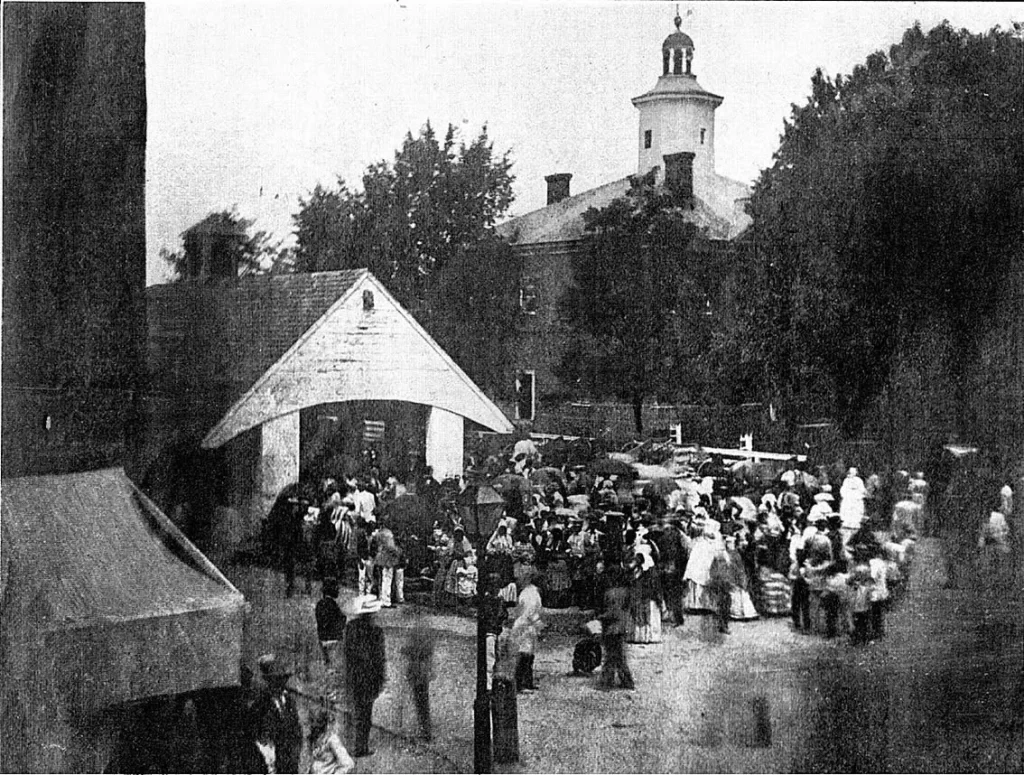
Slave Auction in town square of Easton, MD in 1850's (Public Domain)
Please follow us on Gab, Minds, Telegram, Rumble, Truth Social, Gettr, Twitter
Slavery did exist here, however. Before the 1700's white people, mostly Irish and Scots, worked as indentured servants which meant that after a certain amount of time they might be freed. Sometimes they were, and sometimes they were not, due to legal loopholes. In the 1700's, the chattel slavery of Africans grew in Maryland, even after the slave trade was abolished in 1807. Slavery did not end until the passing of the new Maryland Constitution in 1864. Slavery in Maryland was abolished by the new state constitution, NOT by the Emancipation Proclamation of 1863, which did not free a single slave, as it only applied to enslaved persons in the Confederacy. From History:
The United States was not alone in outlawing the slave trade—all major slaving nations abolished it by 1836—but that didn’t end anti-Black racism or the profit motive. Global demand for sugar, coffee and cotton grew enormously in the 1800s, and planters in the Americas sought captive laborers to help them meet it. Traffickers themselves had big incentives to defy international abolition: Profits for slave traders rose to 90 percent, up tenfold from a century earlier.
The United States played a key role in this illegal traffic from the start. Slave traders brought some 8,000 captives to the American South in the decades after the 1807 ban, including hundreds just before the Civil War. Among the last captives brought to U.S. soil was Oluale Kossola (renamed Cudjo Lewis), a young Yoruba man who sailed aboard the Clotilda, the last slave ship to arrive in the United States in 1860; before his death in 1935, he gave a powerful series of interviews to anthropologist Zora Neale Hurston, chronicling the trauma of being captured, sold and shipped to a foreign place to live—and labor—in bondage. (Read more.)
Native Americans were also enslaved in the American colonies. From Voice of America:
Slavery in America is usually associated with Africa and the American South. But Ohio State University historian Margaret Ellen Newell told VOA that up until 1700, Native Americans comprised the majority of slaves in America.
“The first documented case was in 1605, when an English expedition captured four Wabanakis in what’s now Maine and brought them back to London,” Newell said. “The expedition was run by a man named Ferdinando Gorges, who hoped to establish a colony in northern New England and was looking for captives to use as guides and interpreters.”
Since the start of their settlement, Puritan colonists sought Indians as indentured servants as a solution to labor shortages, she said. (Read more.)
A few years ago in The Netherlands an exhibition of the artifacts related to the Dutch participation in the slave trade was organized in Amsterdam. From ArtNet News:
The Rijksmuseum in Amsterdam has unveiled its landmark exhibition, “Slavery” (through August 29), an unprecedented survey of 10 personal stories of those who were involved in the slave trade, either as profiteers or victims, as it made its way across the Atlantic and Indian Oceans and into the Netherlands’ various colonies.
The show, which has been four years in the making, includes 140 objects from the 17th through 19th centuries, and includes two towering Rembrandt portraits of Oopjen Coppit and Marten Soolmans, who were the ultra-wealthy beneficiaries of a sugar refinery, as well as disturbing artifacts such as collars that were forced on enslaved peoples and gifts exchanged between an African monarch and a slave trader.
Among the stories told is that of Wally, an enslaved man forced to work a sugar plantation in the colony of Suriname. Along with others, Wally organized a failed revolt on the plantation and fled, a crime for which he was executed by immolation in 1707. (Read more.)
The last century has seen growing archaeological and anthropological research about the lives of enslaved persons in Maryland. More is being discovered all the time. From Atlas Obscura:
IN HER 1931 DOCUMENTATION OF African-American spiritual practices, author and anthropologist Zora Neale Hurston wrote about Hoodoo, a set of traditions created by enslaved Africans in North America, with roots in indigenous West African religion. These practices were fundamental to the way the enslaved people defined their relationship to the world, to life, to death, and to each other. In the late 1980s, archaeologists began to make connections between these traditions and some of the material evidence they were uncovering at former plantation sites. From the discovery of crystals and other objects during 1986 and 1991 excavations at the Mont Clare Mansion in Baltimore, to the bundle of objects unearthed beneath a street in Annapolis in 2008, these artifacts can paint a clearer, more nuanced picture of the lives of enslaved people.
Recently, Maryland, the site of those other finds, has continued to produce such historical insights. In August 2022, a team of archaeologists led by Julie Schablitsky, chief of cultural resources at the Maryland Department of Transportation, discovered another spiritual cache at the Thompson Farm, the birthplace of abolitionist Harriet Tubman, in Dorchester County. This latest discovery, along with the foundations of a home, provide a window into the complex spiritual lives of the 40 or so people enslaved at Anthony Thompson’s plantation, and a new perspective on where the famed Underground Railroad activist was raised.
Since fall 2020, Schablitsky and her team have been excavating public and private property that was once part of the farm. Their first discovery was the home of Ben Ross, Tubman’s father. On the land that is now part of the Blackwater National Wildlife Refuge, they also found artifacts dating back to the 1800s, including nails, bricks, and dish fragments. (Read more.)